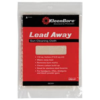Howdy
I have said this a million times. I never worry about the carbon rings blasted onto the surface of a revolver. They occur as high pressure gas and fouling are blasted out of the barrel/cylinder gap. Unlike fouling on the rest of the gun, the pressure they are blasted out under bonds them quite strongly to the front surface of the cylinder. There are all kinds of advice for removing them, I never bother because they always return the next time I fire the gun. I always say if you are still trying to scrub the carbon rings off the front of a cylinder, you don't have enough revolvers. Once you have enough, you will stop worrying about the carbon rings.
Also, never use steel wool to clean a stainless gun. Not even 0000 grade. Tiny shards of steel wool can break off and embed themselves in the steel. Stainless steel is defined as having a certain percentage of chromium in the alloy, I can't remember how much right now. Under normal circumstances a thin, invisible layer of chromium oxide naturally occurs on the surface of stainless steel that forms a barrier against atmospheric oxygen reaching the surface of the steel. This is a naturally occurring phenomenon, it protects the surface of the steel from corroding. If you scratch the surface a new layer of chromium oxide forms and protects the new surface. If tiny shards of steel wool, which is not stainless, are embedded in the surface, it interrupts the ability of the chromium oxide from forming a protective layer around the shard, and tiny rust spots can appear. If you want to scrub the surface of stainless steel with something more aggressive than a bright boy or an eraser, buy some bronze wool from Brownells. It will not hurt the surface of stainless steel.
By the way, stainless steel is never truly stainless, you can get it to corrode if you try hard enough. It also depends on the specific alloy. There are many, many different alloys of stainless steel, each with a different chemical makeup and different purposes. I had some cheap 'stainless' steak knives that I eventually threw out because they developed rust spots every time they went through the dishwasher. A zillion years ago when I used to specify materials for parts, we never used the term Stainless Steel. We always called out Corrosion Resistant Steel, along with whatever specific alloy we wanted. The term 'resistant ' is much more accurate when describing this type of steel.






